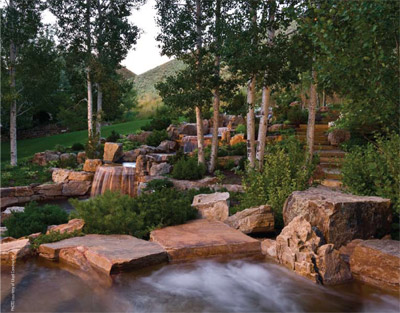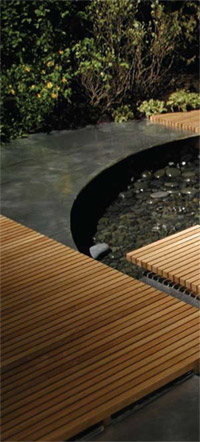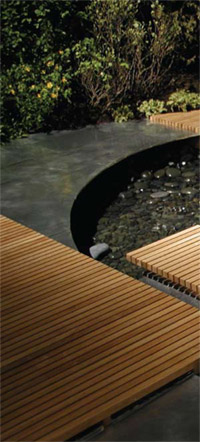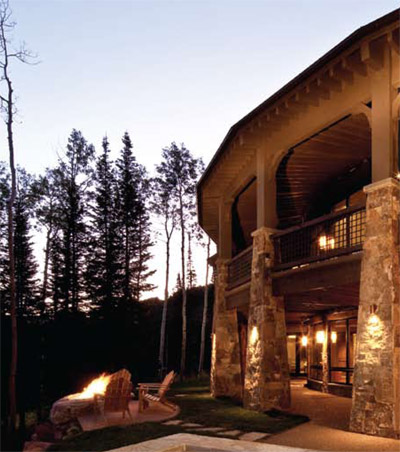The days are longer, and it’s finally comfortable outdoors without all those layers of clothes. What better place to celebrate the arrival of warm weather than in our own backyards? Backyards have come a long way since our childhood experiences of an expanse of flat lawn. Now, our yards are an extension of the living space of our homes. They are places we cook, dine, relax and recreate.
 Design and Composition Design and Composition
The same design principles used for interiors apply to outdoor landscapes. Rhythm, motion, variety, color, texture, and contrast weave together. Spots of  rest and quiet are set off from active areas, and scale, balance and symmetry provide a foundation for harmony. But, designing outdoor spaces also must connect our senses to fragrances, subtle changes in temperature, and the rustle of breezes and songs of birds. Also, in addition to outdoor furnishings and hardscape (concrete, gravel, rock features, shade structures, and the like), the design palette comes from living trees, shrubs, flowers, grasses and vines and their individual demands for soil, moisture, temperature and light. Focusing on function helps manage the complexity of the design elements. Pathways, porches, and patios transition movement from the inside the home to outside and link garden spaces that echo the function of rooms in a home. Garden rooms can be differentiated from the rest of the yard by a number of ways. Deck, patios, pea gravel, or ground covers can serve as the ground surface; low garden walls, decorative fences, shrubs, vines or trees can serve as walls; and a pergola, canopy, umbrella, or shade tree form the room from the top. The amenities complete the outdoor rooms. Lighting, fireplaces, and heaters extend the enjoyment into the evening and add comfort as the season changes. In the heat of the summer, fans and pools cool. Evenings, the warm encompassing water of spas melt away any worries of the day and fireplaces gather people for conversation and stories. Perhaps there have been no greater advances than in the area of outdoor kitchens, as home cooks can prepare feasts by never entering their indoor kitchens. rest and quiet are set off from active areas, and scale, balance and symmetry provide a foundation for harmony. But, designing outdoor spaces also must connect our senses to fragrances, subtle changes in temperature, and the rustle of breezes and songs of birds. Also, in addition to outdoor furnishings and hardscape (concrete, gravel, rock features, shade structures, and the like), the design palette comes from living trees, shrubs, flowers, grasses and vines and their individual demands for soil, moisture, temperature and light. Focusing on function helps manage the complexity of the design elements. Pathways, porches, and patios transition movement from the inside the home to outside and link garden spaces that echo the function of rooms in a home. Garden rooms can be differentiated from the rest of the yard by a number of ways. Deck, patios, pea gravel, or ground covers can serve as the ground surface; low garden walls, decorative fences, shrubs, vines or trees can serve as walls; and a pergola, canopy, umbrella, or shade tree form the room from the top. The amenities complete the outdoor rooms. Lighting, fireplaces, and heaters extend the enjoyment into the evening and add comfort as the season changes. In the heat of the summer, fans and pools cool. Evenings, the warm encompassing water of spas melt away any worries of the day and fireplaces gather people for conversation and stories. Perhaps there have been no greater advances than in the area of outdoor kitchens, as home cooks can prepare feasts by never entering their indoor kitchens.
 Vacations Inspire Design Vacations Inspire Design
When searching for an overall theme for the design, television’s landscape expert Michael Glassman says to look to your favorite vacation destination. He uses examples of his own designs in his book, Garden Getaways. For a couple that loves going to New Orleans, their backyard is a brick patio with an ornate tiered fountain edged by wrought iron and trimmed boxwoods like the French Quarter.  A sound system pipes in jazz, and the outdoor kitchen turns out jambalaya. Another client goes to a sleepy Costa Rican fishing village, and his design has faded painted walls, a small casita bar, and a winding stream through lush plantings of jewel-toned blossoms that carry floating fragrances. Vacations are a great indicator of the degree of formality versus natural design that appeals to you. Also, recalling pleasures on a vacation tells you whether you enjoy big expansive views or being enclosed in a grove. Do you enjoy heat, shade, or a combination? Is dining outside appealing, or do you want to be screened from insects? For many, it is a very useful starting point. For my own half-acre, I realized that hiking and viewing wildlife had the greatest appeal, so I have a wildlife- friendly habitat of berries, water, and a thick canopy growing in of deciduous trees. I alternated dense plantings with glimpses of clearings. The dining spaces are informal like relaxed spaces in a park for a cookout. A sound system pipes in jazz, and the outdoor kitchen turns out jambalaya. Another client goes to a sleepy Costa Rican fishing village, and his design has faded painted walls, a small casita bar, and a winding stream through lush plantings of jewel-toned blossoms that carry floating fragrances. Vacations are a great indicator of the degree of formality versus natural design that appeals to you. Also, recalling pleasures on a vacation tells you whether you enjoy big expansive views or being enclosed in a grove. Do you enjoy heat, shade, or a combination? Is dining outside appealing, or do you want to be screened from insects? For many, it is a very useful starting point. For my own half-acre, I realized that hiking and viewing wildlife had the greatest appeal, so I have a wildlife- friendly habitat of berries, water, and a thick canopy growing in of deciduous trees. I alternated dense plantings with glimpses of clearings. The dining spaces are informal like relaxed spaces in a park for a cookout.
A successful design also avoids and solves problems. The best starting point is to list the issues you face with your property and to incorporate them into the design as you address other needs.
Common landscape problems include visual privacy, glaring western sun, street and neighbor noise, an unsightly wall or garage, and an odd lot configuration. Solving problems like damping and muffling noise can greatly increase your sense of privacy and the enjoyment of your yard. Walls and plantings can block some of the noise, and a water feature or fountain nicely muffles them. So, instead of hearing the neighbor children work out their problems, sounds of rushing and falling water drowns them out. All the other common landscape problems have similarly simple solutions. Whether someone is moving in or has been in a home a while, it is not too difficult to make a backyard a place to relax and play. It’s something one can accomplish alone with good forethought and a little knack. Fortunately, there are many fine local professionals for assisting with the design; building walls, fences, patios, rockscapes, and pergolas; finding furniture; installing pools, spas and water features; providing lighting and audio with handy controls; and augmenting the soil, installing sprinkling systems, and recommending and planting the most appropriate plants, shrubs and trees. Summers are too just short to spend time indoors.
Ann Zimmerman is a frequent contributor and the author of The Comfortable Garden.
She collaborated with Michael Glassman on Garden Getaways.
|
[bannergarden id=”1″] |